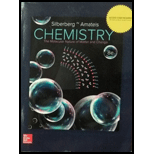
Concept explainers
(a)
Interpretation:
The balanced equation for the reaction is to be written. Also, the reducing and oxidizing agent is to be identified.
Concept introduction:
A
An oxidizing agent is a substance that oxidizes another species and itself gets reduced in a
(a)
Answer to Problem 4.155P
The balanced equation for the reaction is as follows:
The reducing agent is
Explanation of Solution
The given balanced chemical reaction is as follows:
The oxidation number of aluminium is
The expression to calculate the oxidation number of chlorine in
Rearrange equation (1) for the oxidation number of chlorine.
Substitute
The expression to calculate the oxidation number of chlorine in
Rearrange equation (3) for the oxidation number of chlorine.
Substitute
The oxidation state of chlorine in
The oxidation state of aluminium in
An oxidizing agent is a substance that oxidizes another species and itself gets reduced in a chemical reaction. A reducing agent is the one that reduces another species and itself gets oxidized in a chemical reaction.
(b)
Interpretation:
The total mole of gas produced when
Concept introduction:
The expression to calculate the moles of solute when given mass and molecular mass of compound are given is as follows:
Stoichiometry of a reaction is utilized to determine the amount of any species in the reaction by the relationship between the reactants and products.
Consider the general reaction,
One mole of
(b)
Answer to Problem 4.155P
Explanation of Solution
The given balanced chemical reaction is as follows:
The formula to calculate the moles of
Substitute
The formula to calculate the moles of gas is as follows:
Substitute
Stoichiometry of a reaction can be used to determine the moles of a chemical species when the moles of other chemical species present in the reaction is given.
(c)
Interpretation:
The change in volume from the reaction is to be calculated.
Concept introduction:
Density is defined as mass per unit volume. Mass and volume are physical quantities and the units of mass and volume are fundamental units. Density is the ratio of mass to the volume. The unit of volume is derived from the units of mass and volume. The SI unit of density is
Stoichiometry of a reaction is utilized to determine the amount of any species in the reaction by the relationship between the reactants and products.
Consider the general reaction,
One mole of
The conversion factor to convert
(c)
Answer to Problem 4.155P
The change in volume is
Explanation of Solution
The given balanced chemical reaction is as follows:
Rearrange the equation (7) to calculate the volume.
Substitute
The formula to calculate the mass of
Substitute
Substitute
The formula to calculate the initial volume is as follows:
Substitute
The formula to calculate the mass of
Substitute
Substitute
The formula to calculate the mass of
Substitute
Substitute
The volume of one mole of gas at STP is
The formula to calculate the final volume is as follows:
Substitute
The formula to calculate the volume change is as follows:
Substitute
The volume change in a reaction is defined as the difference between volume of reactants and the volume of products.
Want to see more full solutions like this?
Chapter 4 Solutions
CHEMISTRY >CUSTOM<
- Please predict the products for each of the following reactions: 1.03 2. H₂O NaNH, 1. n-BuLi 2. Mel A H₂ 10 9 0 H2SO4, H₂O HgSO4 Pd or Pt (catalyst) B 9 2 n-BuLi ♡ D2 (deuterium) Lindlar's Catalyst 1. NaNH2 2. EtBr Na, ND3 (deuterium) 2. H₂O2, NaOH 1. (Sia)2BH с Darrow_forwardin the scope of ontario SCH4U grade 12 course, please show ALL workarrow_forwardIs the chemical reaction CuCl42-(green) + 4H2O <==> Cu(H2O)42+(blue) + 4Cl- exothermic or endothermic?arrow_forward
- If we react tetraethoxypropane with hydrazine, what is the product obtained (explain its formula). State the reason why the corresponding dialdehyde is not used.arrow_forwarddrawing, no aiarrow_forwardIf CH3COCH2CH(OCH3)2 (4,4-dimethoxy-2-butanone) and hydrazine react, two isomeric products are formed. State their structure and which will be the majority.arrow_forward
- + Reset Provide the correct IUPAC name for the compound shown here. 4-methylhept-2-ene (Z)- (E)- 1-6-5-2-3-4- cyclo iso tert- sec- di tri hept hex oct meth eth pent ane yne ene ylarrow_forward+ Provide the correct IUPAC name for the compound shown here. Reset H3C H H C CH3 CH-CH3 1-3-methylpent ene trans- cis- 5-6-3-1-2-4- tert- tri sec- di cyclo iso but pent hex meth prop eth yl ane ene yne ☑arrow_forwarddrawing, no aiarrow_forward
 ChemistryChemistryISBN:9781305957404Author:Steven S. Zumdahl, Susan A. Zumdahl, Donald J. DeCostePublisher:Cengage Learning
ChemistryChemistryISBN:9781305957404Author:Steven S. Zumdahl, Susan A. Zumdahl, Donald J. DeCostePublisher:Cengage Learning ChemistryChemistryISBN:9781259911156Author:Raymond Chang Dr., Jason Overby ProfessorPublisher:McGraw-Hill Education
ChemistryChemistryISBN:9781259911156Author:Raymond Chang Dr., Jason Overby ProfessorPublisher:McGraw-Hill Education Principles of Instrumental AnalysisChemistryISBN:9781305577213Author:Douglas A. Skoog, F. James Holler, Stanley R. CrouchPublisher:Cengage Learning
Principles of Instrumental AnalysisChemistryISBN:9781305577213Author:Douglas A. Skoog, F. James Holler, Stanley R. CrouchPublisher:Cengage Learning Organic ChemistryChemistryISBN:9780078021558Author:Janice Gorzynski Smith Dr.Publisher:McGraw-Hill Education
Organic ChemistryChemistryISBN:9780078021558Author:Janice Gorzynski Smith Dr.Publisher:McGraw-Hill Education Chemistry: Principles and ReactionsChemistryISBN:9781305079373Author:William L. Masterton, Cecile N. HurleyPublisher:Cengage Learning
Chemistry: Principles and ReactionsChemistryISBN:9781305079373Author:William L. Masterton, Cecile N. HurleyPublisher:Cengage Learning Elementary Principles of Chemical Processes, Bind...ChemistryISBN:9781118431221Author:Richard M. Felder, Ronald W. Rousseau, Lisa G. BullardPublisher:WILEY
Elementary Principles of Chemical Processes, Bind...ChemistryISBN:9781118431221Author:Richard M. Felder, Ronald W. Rousseau, Lisa G. BullardPublisher:WILEY





